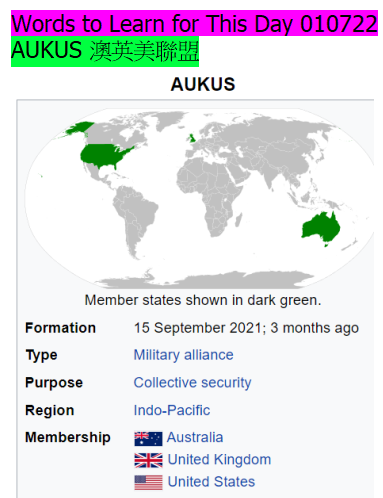Why Biden Wants Taiwan/拜登支持台灣的理由
South China Sea Energy Exploration and Development
The U.S. Energy Information Agency estimates that the South China Sea holds about 190 trillion cubic feet of natural gas and 11 billion barrels of oil in proved and probable reserves, most of which lie along the margins of the South China Sea rather than under disputed islets and reefs. The U.S. Geological Survey in 2012 estimated that there could be another 160 trillion cubic feet of natural gas and 12 billion barrels of oil undiscovered in the South China Sea. Beijing’s estimates for hydrocarbon resources under the sea are considerably higher but still modest in relation to China’s overall demand—the country’s oil consumption in 2018 is expected to top 12.8 million barrels per day... more
The U.S. Energy Information Agency estimates that the South China Sea holds about 190 trillion cubic feet of natural gas and 11 billion barrels of oil in proved and probable reserves, most of which lie along the margins of the South China Sea rather than under disputed islets and reefs. The U.S. Geological Survey in 2012 estimated that there could be another 160 trillion cubic feet of natural gas and 12 billion barrels of oil undiscovered in the South China Sea. Beijing’s estimates for hydrocarbon resources under the sea are considerably higher but still modest in relation to China’s overall demand—the country’s oil consumption in 2018 is expected to top 12.8 million barrels per day... more
US 'sends carrier strike group' to South China Sea
It comes as the US ramps up pressure on Beijing, laying out its most detailed case yet against 'unlawful' territorial claims
Jan. 14 - The United States has reportedly deployed carrier strike groups for drills in the contested South China Sea as it ramps up its opposition to Beijing’s maritime claims in the region.
The USS Carl Vinson and USS Essex, a Wasp-class Landing Helicopter Dock - along with their escort vessels - entered the southern waters of the sea on Tuesday, said Beijing-based think tank, the South China Sea Strategic Situation Probing Initiative.
According to the South China Morning Post, the US Navy is expected to conduct joint drills in the strategic international waterways, whose islands, atolls and reefs are subject to territorial disputes between China and several Southeast Asian nations including the Philippines and Vietnam.
The exercises have so far not been confirmed by the United States Navy...
...The South China Sea is rich with oil and gas deposits and is crucial for international shipping. Beijing’s increasing swagger in the region has prompted alarm and a growth in “freedom of navigation” operations by the US and its allies.... quoted from The Telegraph
It comes as the US ramps up pressure on Beijing, laying out its most detailed case yet against 'unlawful' territorial claims
Jan. 14 - The United States has reportedly deployed carrier strike groups for drills in the contested South China Sea as it ramps up its opposition to Beijing’s maritime claims in the region.
The USS Carl Vinson and USS Essex, a Wasp-class Landing Helicopter Dock - along with their escort vessels - entered the southern waters of the sea on Tuesday, said Beijing-based think tank, the South China Sea Strategic Situation Probing Initiative.
According to the South China Morning Post, the US Navy is expected to conduct joint drills in the strategic international waterways, whose islands, atolls and reefs are subject to territorial disputes between China and several Southeast Asian nations including the Philippines and Vietnam.
The exercises have so far not been confirmed by the United States Navy...
...The South China Sea is rich with oil and gas deposits and is crucial for international shipping. Beijing’s increasing swagger in the region has prompted alarm and a growth in “freedom of navigation” operations by the US and its allies.... quoted from The Telegraph
The South China Sea Enigma
Rasoul Sorkhabi, Ph.D.
The South China Sea, a marginal sea between Asia (the largest continent) and the Pacific (the largest ocean) covers an area of 3.5 million square kilometres and is surrounded by sedimentary basins, some of which have produced petroleum for decades. The oceanic and the stretched continental crusts underlying the South China Sea have experienced a complex tectonic history in Cenozoic times, which geologists are only beginning to unravel.
This article appeared in Vol. 10, No. 1 - 2013
The South China Sea Basin is one of the largest marginal basins in Asia. South China Sea is located to the east of Vietnam, west of Philippines and the Luzon Strait, and north of Borneo. Tectonically, it is surrounded by the Indochina Block on the west, Philippines Sea plate on the east, Yangtze Block to the north. A subduction boundary exists between the Philippines Sea Plate and the Asian Plate. The formation of the South China Sea Basin was closely related with the collision between the Indian Plate and Eurasian Plates. The collision thickened the continental crust and changed the elevation of the topography from the Himalayan orogenic zone to the South China Sea, especially around the Tibetan Plateau. The location of the South China Sea makes it a product of several tectonic events. All the plates around the South China Sea Basin underwent clockwise rotation, subduction and experienced an extrusion process from the early Cenozoic to the Late Miocene.
The geological history can be classified into five tectonic evolutionary stages. (1) rift system development (2) sea floor spreading, (3) subsidence of the South China Sea, (4) closure of the South China Sea Basin and (5) uplift of Taiwan. quoted from Wikipedia
The geological history can be classified into five tectonic evolutionary stages. (1) rift system development (2) sea floor spreading, (3) subsidence of the South China Sea, (4) closure of the South China Sea Basin and (5) uplift of Taiwan. quoted from Wikipedia








